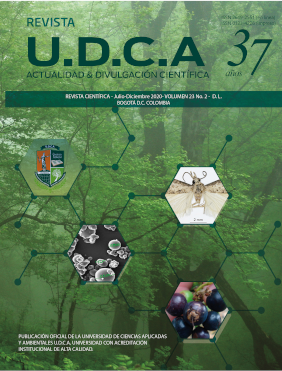Desarrollo de una bebida energizante con pulpa de maracuyá, cristales de aloe vera, panela y propiedades antioxidantes
Development of an energy drink with passion fruit pulp, aloe vera crystals, panela and antioxidant properties
Contenido principal del artículo
Resumen
En los últimos años, la demanda de productos saludables se ha venido incrementando, con lo cual, muchas investigaciones se han focalizado hacia la producción de alimentos y bebidas con potencial nutracéutico. El objetivo de este trabajo fue desarrollar una bebida energizante, a base de panela, jugo de maracuyá, cristales de aloe vera (AV), con propiedades antioxidantes. Se evaluó el contenido de compuestos fenólicos, ácido ascórbico y la capacidad antirradicalaria de las materias primas y las bebidas producidas. Se realizó un análisis sensorial, para verificar la aceptación del sabor, color, textura del AV y la aceptabilidad global de tres bebidas, seleccionadas de acuerdo con sus propiedades antioxidantes. Los resultados mostraron que la panela tenía el mayor contenido de compuestos fenólicos (59,4 ± 0,2mg AGE/g), mientras que el jugo de maracuyá, la mayor actividad antirradicalaria (657 ± 5µg eq AA/mL). Las bebidas analizadas dentro del diseño experimental variaron su actividad antioxidante, con la variación de los factores. De las tres bebidas seleccionadas, la bebida 2 presentó la mayor capacidad antirradicalaria (419 ± 1µg eq AA/mL) y contenido de vitamina C (15,75 ± 0,03µg/mL) y, además, un importante contenido de compuestos fenólicos (7,6 ± 2mg AGE/mL). Asimismo, los resultados del panel sensorial mostraron que la bebida 2 tenía una alta aceptabilidad global y una mayor aceptación del sabor, por lo cual, se puede concluir que esta bebida, es la que presenta mayor potencial antioxidante y comercial.
Palabras clave:
Descargas
Datos de publicación
Perfil evaluadores/as N/D
Declaraciones de autoría
- Sociedad académica
- Universidad de Ciencias Aplicadas UDCA
- Editorial
- Universidad de Ciencias Aplicadas y Ambientales U.D.C.A
Detalles del artículo
Referencias (VER)
BROWN, P.N.; YU, R.; KUAN, C.H.; FINLEY, J.; MUDGE, E.M.; DENTALI, S. 2014. Determination of Aloin A and Aloin B in Aloe vera raw materials and finished products by high-performance liquid chromatography: single-laboratory validation. J. AOAC Int. (Reino Unido). 97(5):1323-1328. https://doi.org/10.5740/jaoacint.13-028
CARBONELL-CAPELLA, J.M.; BUNIOWSKA, M.; ESTEVE, M.J.; FRÍGOLA, A. 2015. Effect of Stevia rebaudiana addition on bioaccessibility of bioactive compounds and antioxidant activity of beverages based on exotic fruits mixed with oat following simulated human digestion. Food Chem. (Holanda). 184:122-130. https://doi.org/10.1016/j.foodchem.2015.03.095
CEDILLO, C.; GASTÉLUM-BARRIOS, A. 2015. Desarrollo tecnológico de remoción de aloína en sistema continuo de adsorción en columna . In Proceedings 3er. Congreso Internacional de Ingeniería y Tecnología, Universidad del SABES. San Miguel de Allende, Gto., México: Universidad del SABES. Disponible desde Internet en: https://www.researchgate.net/profile/Abraham_Gastelum_Barrios/publication/314500750_Desarrollo_tecnologico_de_remocion_de_aloina_en_sistema_continuo_de_adsorcion_en_columna_Diseno_y_perspectivas_de_monitoreo/links/58c2c82d92851c0ccbf114e8/Desarrollo-tecno (con acceso 24/04/20).
CODEX/FAO. 2008. PROGRAMA CONJUNTO FAO/OMS SOBRE NORMAS ALIMENTARIAS COMITÉ DEL CODEX SOBRE ADITIVOS ALIMENTARIOS 40a reunión. Beijing (China). Disponible desde internet en: http://www.fao.org/tempref/codex/Meetings/CCFA/ccfa40/fa40_08s.pdf (con acceso 24/04/20).
DE MARIA, G. 2013. Panela: The natural nutritional sweetener. Agro Food Ind Hi-Tec. (Italia). 24(6):44-48.
DE SANTANA, F.C.; DE OLIVEIRA TORRES, L.R.; SHINAGAWA, F.B.; DE OLIVEIRA E SILVA, A.M.; YOSHIME, L.T.; DE MELO, I.L.P.; MARCELLINI, P.S.; MANCINI-FILHO, J. 2017. Optimization of the antioxidant polyphenolic compounds extraction of yellow passion fruit seeds (Passiflora edulis Sims) by response surface methodology. J Food Sci and Tec. (India). 54(11):3552-3561. https://doi.org/10.1007/s13197-017-2813-3
GUTIÉRREZ PULIDO, H.; DE LA VARA SALAZAR, R. 2008. Análisis y diseño de experimentos. McGraw-Hill Interamericana. (México DF). 488p.
LAWLESS, H. 2013. Quantitative Sensory Analysis. Psychophysics, Models and Intelligent Design. Ed. Wiley-Blackwell (Reino Unido).p.167-170.
LÓPEZ MOLINA, M.G.; CRUZ VÁSQUEZ, M.; BUITRÓN MORALES, P.; DE LAROCHA SOSA, A. 2016. Modelo de negocio de alimentos procesados saludables: Estudio de caso con análisis de la propuesta de valor. Strateg. Technol. & Soc. (México). 3(2):43-68.
LÓPEZ-PALACIOS, K.; GONZALES-CORTÉS, N.; MALDONADO-ENRIQUEZ, A.; JIMENEZ, L.; JIMENEZ-VERA, R. 2019. Jugo de betabel (Beta vulgaris L.) y panela fermentados con Saccharomyces bayanus. In Crescendo. (Peru). 9(3):367-378.
MANGANARIS, G.A.; GOULAS, V.; VICENTE, A.R.; TERRY, L.A. 2014. Berry antioxidants: Small fruits providing large benefits. J. Sci. Food Agric. (Estados Unidos). 94(5):825-833. https://doi.org/10.1002/jsfa.6432
MARTÍNEZ, W.J.; PATERNINA-ARBOLEDA, C.D.; PARODDY, A.; VÉLEZ RAMÍREZ, M.; TAPIA, L.P.; ESPITIA, R. 2017. Optimización del proceso de eliminación de aloína del gel fileteado mecánico de Aloe vera concentrado 10X. Cumbres. (Ecuador). 3(2):9-16.
MINISTERIO DE LA PROTECCIÓN SOCIAL. 2009. RESOLUCIÓN 4150 DE 2009. Por la cual se establece el reglamento técnico sobre los requisitos que deben cumplir las bebidas energizantes para consumo humano. Disponible desde Internet en: https://www.minsalud.gov.co/sites/rid/Lists/BibliotecaDigital/RIDE/DE/DIJ/Resolucion-4150-de-2009.pdf (con acceso 09/07/2020)
NAZIR, A.; AHSAN, H. 2017. Health benefits of aloe vera : A wonder plant. Int. J. Chem. Stud. (India). 5(6):967-969.
NIETO CALVACHE, J.E.; CUETO, M.; FARRONI, A.; DE ESCALADA PLA, M.F.; GERSCHENSON, L.N. 2016. Antioxidant characterization of new dietary fiber concentrates from papaya pulp and peel (Carica papaya L.). J. Funct. Foods. (Holanda). 27:319-328. http://dx.doi.org/10.1016/j.jff.2016.09.012
NIETO-CALVACHE, J.E.; DE ESCALADA PLA, M.; GERSCHENSON, L.N. 2018. Dietary fibre concentrates produced from papaya by-products for agroindustrial waste valorisation. Int. J. Food Sci. Technol. (Reino Unido). 1:1-7. https://doi.org/10.1111/ijfs.13962
PETRUZZI, L.; CAMPANIELLO, D.; SPERANZA, B.; CORBO, M.R.; SINIGAGLIA, M.; BEVILACQUA, A. 2017. Thermal treatments for fruit and vegetable juices and beverages: A literature overview. Compr. Rev. Food Sci. Food Saf. (Estados Unidos). 16(4):668-691. https://doi.org/10.1111/1541-4337.12270
RADHA, M.H.; LAXMIPRIYA, N.P. 2015. Evaluation of biological properties and clinical effectiveness of Aloe vera: A systematic review. J. Tradit. Complement. Med. (Holanda) 5(1):21-26. https://doi.org/10.1016/j.jtcme.2014.10.006
RODRÍGUEZ VILLACIS, D.; HERNÁNDEZ MONZON, A.; RODRÍGUEZ SANCHEZ, J.L. 2019. Caracterización de una bebida fermentada de lactosuero con la adición de jugo de sábila (Aloe vera L.) y pulpa de mora (Rubus glaucus Bent). Cienc. y Tecnol. Aliment. (Cuba). 29(1):7-14.
ROTTA, E.M.; RODRIGUES, C.A.; JARDIM, I.C.S.F.; MALDANER, L.; VISENTAINER, J.V. 2019. Determination of phenolic compounds and antioxidant activity in passion fruit pulp (Passiflora spp.) using a modified QuEChERS method and UHPLC-MS/MS. LWT. (Estados Unidos). 100:397-403. https://doi.org/10.1016/J.LWT.2018.10.052
SALAMANCA GROSSO, G.; REYES MÉNDEZ, L.M.; OSORIO TANGARIFE, M.P.; RODRÍGUEZ ARIAS, N. 2015. Diseño experimental de mezclas como herramienta para la optimización de cremolácteos de mango. Rev. Col. Investig. Agroindustriales. 2:16-24. https://doi.org/10.23850/24220582.166
SÁNCHEZ, J.C.; ROMERO, C.R.; ARROYAVE, C.D.; GARCÍA, A.M.; GIRALDO, F.D.; SÁNCHEZ, L.V. 2015. Bebidas energizantes: efectos benéficos y perjudiciales para la salud. Perspect. Nutr. Humana. (Colombia). 17(1):79-91. https://doi.org/10.17533/udea.penh.v17n1a07
SÁNCHEZ-MACHADO, D.I.; LÓPEZ-CERVANTES, J.; SENDÓN, R.; SANCHES-SILVA, A. 2017. Aloe vera: Ancient knowledge with new frontiers. Trends Food Sci Technol. (Holanda) 61:94-102. https://doi.org/10.1016/j.tifs.2016.12.005
SIR ELKHATIM, K.A.; ELAGIB, R.A.A.; HASSAN, A.B. 2018. Content of phenolic compounds and vitamin C and antioxidant activity in wasted parts of Sudanese citrus fruits. Food Sci. Nutr. (Reino Unido). 6(5):1214-1219. https://doi.org/10.1002/fsn3.660
STAFUSSA, A.P.; MACIEL, G.M.; RAMPAZZO, V.; BONA, E.; MAKARA, C.N.; DEMCZUK JUNIOR, B.; HAMINIUK, C.W.I. 2018. Bioactive compounds of 44 traditional and exotic brazilian fruit pulps: Phenolic compounds and antioxidant activity. Int. J. Food Prop. (Estados Unidos). 21(1):106-118. https://doi.org/10.1080/10942912.2017.1409761
VEGA G, A.; AMPUERO C, N.; DÍAZ N, L.; LEMUS M, R. 2005. Aloe vera (Aloe barbadensis Miller) as a component of functional foods. Rev. Chil. Nutr (Chile) 32(3):208-214. http://dx.doi.org/10.4067/S0717-75182005000300005
VISRAM, S.; CHEETHAM, M.; RIBY, D.M.; CROSSLEY, S.J.; LAKE, A.A. 2016. Consumption of energy drinks by children and young people: A rapid review examining evidence of physical effects and consumer attitudes. BMJ Open. (Reino Unido). 6(10):e010380. https://doi.org/10.1136/bmjopen-2015-010380







